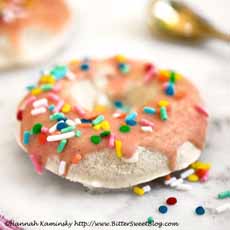TIP OF THE DAY: Ice Cream Donuts
|
A fun project for a long weekend: ice cream donuts. There are two ways to look at them. One requires a donut pan and some fabrication. The other requires nothing but donuts and ice cream. Ingredients 1. SOFTEN the ice cream by leaving the container on the counter for 10 minutes or more. 2. HALVE the donuts. Pile ice cream on the lower half and smooth the edges with a spatula. Add the top donut half. 3a. ROLL the ice cream in a dish of garnishes. Wrap in plastic and return to the freezer to harden – or – 3b. MELT the chocolate in a microwave-safe bowl. Dip part of the donut in the chocolate, then in garnishes as desired. These donuts have no cakey component; they’re solid ice-cream shaped like donuts. You can add a crumb bottom for some donut effect. Ingredients 1. COAT the wells of the pan (photo #2) per manufacturer’s instructions. 2. SOFTEN the ice cream by leaving the container on the counter for 10 minutes or more. 3. SPOON the ice cream into the donut wells. Level with a spatula. Add the optional cake or cookie crumbs and lightly tamp down. Place the pan in the freezer. 4. ASSEMBLE: Invert the pan to remove the donuts. Quickly frost, garnish and serve. Alternatively, just frost and serve the garnishes separately, in DIY fashion. An old word for ball was nut; a doughnut is literally a nut (ball) of dough. |
 [1] The easy way: slice a donut, add the ice cream. Paper ‘N Stitch Blog uses glazed donuts with colorful ice creams, like black cherry chip and mint chocolate chip.
[3] If you invest in a donut pan, you can use it for other things. Check out 101 Donut Pan Ideas. |
|
|
The term “doughnut” was first used in print in 1809 by American author Washington Irving in his satirical “Knickerbocker’s History Of New York.” Irving wrote of: “…balls of sweetened dough, fried in hog’s fat, and called doughnuts, or olykoeks*.” These balls, or nuts of fried dough, are what we now call (in a smaller size) doughnut holes. Because the center of the cake did not cook as quickly as the outside, the softer centers were sometimes stuffed with fruit, nuts, or other fillings that did not require cooking (think of the chopped onions in the center of a bialy). What about the hole? Per Smithsonian, a New England ship captain’s mother made a notably delicious, deep-fried doughnut that used her son’s spice cargo of nutmeg and cinnamon, along with lemon rind. She filled the center with hazelnuts or walnuts. As the story goes, in 1847, 16-year-old sailor Hanson Crockett Gregory created the hole in the center of the doughnut. He used the top of a round tin pepper container to punch the holes, so the dough would cook evenly. He recounted the story in an interview with the Boston Post at the turn of the century, 50 years later. He effectively eliminated the need to fill the less-cooked center, and provided an inner cut-out that enabled the dough to be evenly cooked. Who changed the spelling to donut? The first known printed record of the shortened word “donut” appears (likely an inadvertent misspelling) in “Peck’s Bad Boy And His Pa,” a story by George W. Peck published in 1900. The spelling did not immediately catch on. That impetus goes to Dunkin’ Donuts, founded in 1950. While donut is easier to write, but we prefer the old-fashioned elegance of doughnut. Take your choice. Doughnuts didn’t become a mainstream American food until after World War I. American doughboys at the front were served doughnuts by Salvation Army volunteers. When the doughboys returned, they brought their taste for doughnuts with them [source]. The name doughboy wasn’t related to the doughnuts, by the way. It dates to the Civil War, when the cavalry unchivalrously derided foot soldiers as doughboys. Two theories are offered: ________________ *Olykoek is Dutch for oil cake, i.e., batter fried in oil. While dough was fried the world over, we can thank the Dutch for the sweet balls fried in hog fat that became modern doughnuts. |
||




